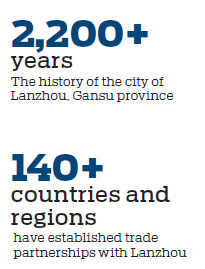City remains key transit hub linking East and West
As one of the birthplaces of Chinese culture, Lanzhou is a city rich in history. Not sitting still, the capital of Gansu province remains a key transport hub with bright prospects for future development.
Though the city itself has a history of more than 2,200 years, people began to live in the area as long as 15,000 years ago, according to relics discovered.
Some 2,000 years ago, Zhang Qian, a traveler and diplomat of the Western Han Dynasty (206 BC-AD 24) was sent as an envoy to the western regions through Lanzhou to open up the Silk Road that runs through Eurasia and connects the East and the West, making Lanzhou an important transit hub and commercial center along the Silk Road.
Nowadays, the city remains one of China's important logistics zones. It has a total of 105,200 commercial service outlets, 158 wholesale markets, 33 key logistics companies and more than 300,000 kinds of products. It has established trade partnerships with more than 140 countries and regions around the world.
Located in Northwest China, the inland transportation hub connects eastern and western China. It has direct flights to Kuala Lumpur, Seoul, China's Taipei and Hong Kong, among others.

Lanzhou is the only provincial capital in China with the Yellow River running through it. The city is rich in natural scenery such as the Shifo valley, Xujia Mountain and Tulu valley. It is also renowned for its specialties ranging from roses, lilies, sweet melons and hand-pulled noodles.
The Gansu capital is also home to multiple ethnic groups. More than 160,000 people of the Gansu capital's population belong to ethnic groups, such as the Hui and Tibetan ethnic groups. The Northwest Minzu University, which is one of the first ethnic colleges in the country, has become a base to cultivate professionals from ethnic groups in the northwest region of China.
The city has more than 1,200 science and research institutes, 10 national-level key laboratories, 21 academicians from the Chinese Academy of Sciences and the Chinese Academy of Engineering, and nearly 300,000 technical professionals.
In 2018, the State Council approved Lanzhou National Hi-Tech Industrial Development Zone and Baiyin Hi-Tech Industrial Development Zone to be developed into national independent high-tech demonstration zones.
As a traditional industrial base, Lanzhou is home to a series of national projects. With years of development, the city has built an industrial system covering petrochemicals, machinery manufacturing, biological medicine and construction materials.
(China Daily 06/05/2019 page12)














